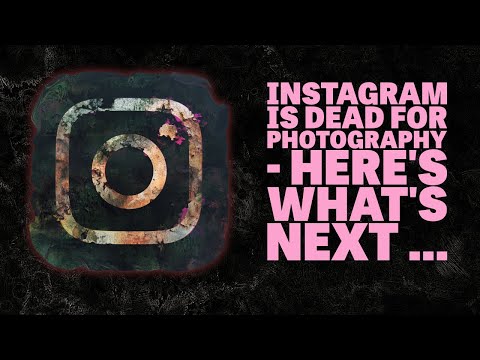Contents
Social media has changed the world in ways we never imagined, but for photographers, it’s been a bit of a rollercoaster. Instagram has been dead for photography for a while now, but what are the alternatives? In his latest video, Andy Hutchinson takes a deep dive into how social media platforms have evolved, what that means for photography, and where we can go next.
Back in its early days, social media was a gift for photographers. It allowed us to share our work with a global audience, connect with other creatives, and even gain recognition. Instagram, in particular, became the go-to platform for photographers. But oh boy, have things changed! Instagram has shifted its focus to short-form video, heavily prioritizing Reels over still images. Facebook has become a pay-to-play space where organic reach is nearly impossible (and if I may add, it’s a sanctuary for AI-generated crap). Twitter is a mess of negativity, and TikTok was never really for photographers anyway.
Andy argues that social media has sucked the soul out of photography, and maybe it’s time for photographers to walk away—or at least explore new spaces.
Where do photographers go from here?
So, mainstream social media isn’t serving photographers anymore. But what are the alternatives? Andy looks at several platforms that are either designed for photographers or offer a better experience than the algorithm-driven giants. Here are some of his suggestions:
BlueSky: A fresh start for photographers
One of the most promising new platforms is BlueSky, a decentralized social media site co-founded by Jack Dorsey (of Twitter fame). Andy has been using it since the early beta stages and sees real potential for photographers.
BlueSky offers high-resolution image uploads, a chronological feed (so you actually see posts in order), and a growing photography community. It’s more like old-school Twitter than Instagram, but it’s a great place to showcase work and connect with like-minded people.
PixelFed: The open-source alternative to Instagram
If you’re looking for something more like Instagram, PixelFed might be worth a shot. It’s an open-source, decentralized platform built specifically for sharing photos. While it has a tiny user base compared to Instagram, it avoids the algorithm-driven madness and lets photographers focus on what really matters—the images.
The downside? It’s still relatively quiet, and adoption has been slow. But with the recent launch of its mobile app, interest has been growing.
Flickr: An old favorite making a comeback
Flickr used to be the place for photographers online. But after a bajillion of ups and downs over the years, it fell out of favor. However, Andy has noticed a renewed interest in the platform, especially from younger photographers who are discovering it for the first time. As a Flickr user of almost 16 years, I must say that I’m pleased to hear this.
Unlike Instagram, Flickr is still all about photography. You can upload full-resolution images, organize them into albums, and even use Flicks as a portfolio. While some of the old discussion forums feel a bit abandoned, the platform itself is still going strong. Andy recently bought a two-year Pro subscription and is slowly reintegrating it into his online presence.
Flashes: A potential Instagram rival in the making
The team behind BlueSky is also working on a dedicated photo-sharing app called Flashes. It’s still in beta, but from what’s been shown so far, it looks a lot like classic Instagram—before Reels took over. Andy sees a lot of potential here, especially since photographers are clearly looking for a new home.
Possibly worth considering: Vero and Glass
Vero
Vero is another Instagram alternative that’s been around for a while. It had two brief moments of popularity—once when it launched in 2018 and again when Peter McKinnon hyped it up. But despite its beautiful design, Andy finds it lacking in engagement and community. I personally have never used it, so I can’t give you my experience. But so far, I’ve abandoned every platform except Flickr and Behance.
Glass
Glass takes a different approach by being a paid platform, which helps keep it free of ads and algorithms. It’s beautifully designed and focused entirely on photography. However, Andy notes that it feels a bit exclusive—like you need to be part of the “in crowd” to really engage with others.
With all these new platforms emerging, Andy encourages photographers to think about what they really want from sharing their work online. If Instagram is still working for you, that’s great. But if you’re just posting out of habit, it might be time to rethink your approach.
One option is to step away from social media altogether and create your own space online. A personal website or portfolio gives you full control and isn’t at risk of being taken over by another algorithm shift. But on the other hand, interaction and connection with other photographers, audiences, and perhaps even potential clients are what make social media useful in a photographer’s life.
As I mentioned, I’ve only kept Flickr and Behance; I’ve had them since 2009 and 2010, respectively. I tried 500px, 1x, EyeEm, and I can’t even remember what else. But none of them sit well with me. I still use Instagram, but only for my everyday life and handmade stuff. And to be honest, I plan to migrate from it and share my handmade work elsewhere.
So, where do you stand? Are you still active on Instagram? Have you tried any of these alternative platforms, or are you considering moving away from social media altogether? Let us know in the comments.
[Instagram for Photographers is Dead – Here’s Where You Should Post Instead | Andy Hutchinson]

